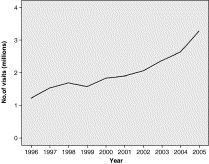National epidemiology of cutaneous abscesses: 1996 to 2005☆

To view the full text, please login as a subscribed user or purchase a subscription. Click here to view the full text on ScienceDirect.

Fig. 1
Total ED visits for abscesses by year 1996 to 2005.
Fig. 2
Distribution of abscess visits by age, 2005.
Fig. 3
Distribution of abscess visits by body region, 2005.
Abstract
Objective
Little has been reported regarding the national epidemiology of cutaneous abscesses. We examined the National Hospital Ambulatory Medical Care Survey (NHAMCS) national estimates of all emergency department (ED) visits from 1996 to 2005 to determine the trend and the epidemiology of ED abscess visits.
Methods
Study design: retrospective analysis of NHAMCS databases for 1996 to 2005 available from the National Center for Health Statistics. Subjects: all patients with a first diagnosis of abscess based on the International Classification of Diseases, Ninth Revision, Clinical Modification, diagnosis codes were selected for analysis. Measures: estimated total numbers and percentages of patients by year. Analysis: trends from 1996 through 2005 were examined overall and by demographic factors (eg, age, sex) and abscess characteristics (eg, body region affected). Linear regression was used to evaluate trends.
Results
Emergency department visits for abscesses more than doubled over the 10-year study period (1.2 million in 1996 to 3.28 million in 2005; trend, P < .01). The total number of ED visits increased from 90 million to 115 million over the same period, so that abscess visits are increasing faster than overall visits. Although the frequency of abscesses increased, the demographic and clinical characteristics of ED patients were unchanged over time. About half of ED patients with abscess were male, and about half were between the ages of 19 and 45 years. Annual admissions hovered around 12%. The most common abscess sites coded were the leg, ear, and “unspecified site.” About 50% received antibiotics.
Conclusions
Emergency department visits for abscesses have shown a large increase since 1996; however, demographic and clinical factors are uniform across years.
To access this article, please choose from the options below
Purchase access to this article
Claim Access
If you are a current subscriber with Society Membership or an Account Number, claim your access now.
Subscribe to this title
Purchase a subscription to gain access to this and all other articles in this journal.
Institutional Access
Visit ScienceDirect to see if you have access via your institution.
☆Presented in part at the 2007 SAEM NY Regional Conference, New York, NY, March 28, 2007.
Related Articles
Searching for related articles..


